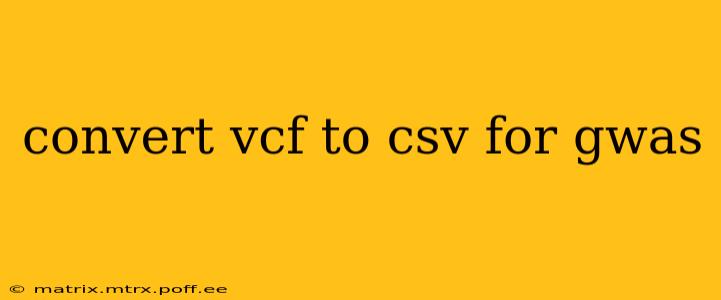Genome-wide association studies (GWAS) rely heavily on well-formatted data. While VCF (Variant Call Format) files are the standard for storing genomic variation data, CSV (Comma Separated Values) files often offer greater compatibility with various statistical analysis tools used in GWAS. This guide details the process of converting VCF to CSV, highlighting crucial considerations for ensuring data integrity and facilitating downstream analyses.
Why Convert VCF to CSV for GWAS?
VCF files, while powerful, can be complex. Their structured format, designed for detailed variant annotation, isn't always the most efficient for statistical software packages employed in GWAS. CSV files, with their simpler structure, provide a more straightforward way to import and analyze data, particularly for tools that aren't explicitly designed to handle VCF's intricate features. This simplification streamlines the analytical process, reducing potential errors and allowing for easier manipulation of the data.
Choosing the Right Tools for VCF to CSV Conversion
Several tools are available for converting VCF files to CSV. The optimal choice depends on the complexity of your VCF file and your familiarity with command-line interfaces versus graphical user interfaces. Here are some popular options:
-
bcftools(Command-line): Part of the HTSlib suite,bcftoolsis a powerful and versatile tool for manipulating VCF and BCF (Binary Call Format) files. It offers precise control over the conversion process, allowing you to select specific columns and apply filters. This is a preferred choice for experienced users comfortable with the command line. -
VCFtools (Command-line): Another command-line tool, VCFtools provides various functionalities, including conversion to other formats. While not directly converting to CSV, it can extract relevant information that can then be easily formatted into a CSV using other tools like
awkor spreadsheet software. -
Python Libraries (Programming): Libraries like
pysamandpandasallow for programmatic manipulation of VCF data. This offers maximum flexibility but requires programming skills. You can write a script tailored to your specific needs, ensuring only the necessary data is extracted and formatted into a CSV. -
Online Converters: Several online tools claim to convert VCF to CSV. Exercise caution when using these, ensuring the service maintains data privacy and security. Always verify the output's accuracy before proceeding with your analysis.
How to use bcftools (Example)
This example demonstrates a basic conversion using bcftools. Adjust the commands based on your specific needs and the contents of your VCF file. Remember to replace <input.vcf> with your input file name and <output.csv> with your desired output file name.
bcftools query -f '%CHROM\t%POS\t%ID\t%REF\t%ALT\t%QUAL\n' <input.vcf> > <output.csv>
This command selects specific fields (chromosome, position, ID, reference allele, alternate allele, and quality) from the VCF file and outputs them to a tab-separated file. You can then easily open this file in a spreadsheet program and save it as a CSV.
What information should be included in the CSV file for GWAS?
The specific columns included in your CSV file will depend on your GWAS analysis. However, some essential columns include:
- Chromosome: The chromosome on which the variant is located.
- Position: The base-pair position of the variant on the chromosome.
- Reference Allele: The allele present in the reference genome.
- Alternate Allele: The variant allele.
- Genotype Data: This will depend on your data, often coded numerically (e.g., 0/0, 0/1, 1/1 representing homozygous reference, heterozygous, and homozygous alternate).
- p-value: (If already calculated) the p-value associated with the variant.
Handling Missing Data and Quality Control
Before conversion, ensure you perform appropriate quality control on your VCF file. This involves handling missing data, filtering out low-quality variants, and ensuring consistent data representation. Poorly prepared data can lead to inaccurate GWAS results. Consider using tools like plink or vcftools for filtering and quality control steps before conversion to CSV.
Conclusion
Converting VCF to CSV for GWAS requires careful consideration of your data and the tools you use. Choosing the right tool, understanding the essential columns to include in your CSV, and performing adequate quality control are crucial steps for a successful GWAS analysis. Remember to thoroughly examine your converted CSV file for accuracy before proceeding with downstream analyses.
